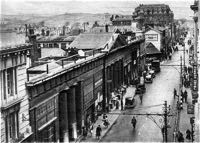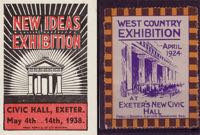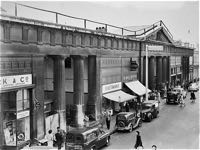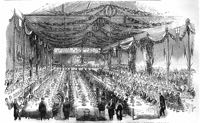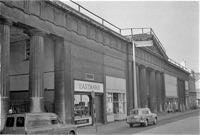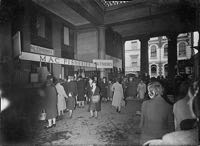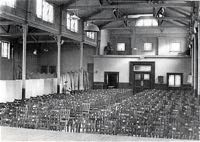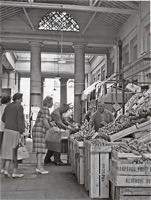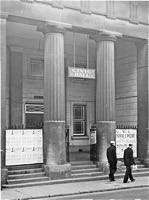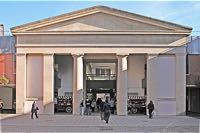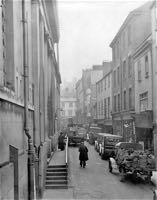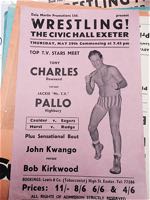
Higher Market - Queen Street
and Civic Hall
Page updated 4th December ber 2017
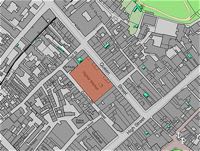 The old livestock market had originally been in the High Street was moved to Higher Market Street in 1691. However, the street was north of the High Street, in a cramped space bounded by Gandy Street and the High Street.
The old livestock market had originally been in the High Street was moved to Higher Market Street in 1691. However, the street was north of the High Street, in a cramped space bounded by Gandy Street and the High Street.
The cholera outbreak of 1832 was a hard lesson for the City Chamber, who were prompted to improve the public health of the city. To this end, the Improvement Commission decided to build two new markets in Exeter, One close to the old Higher Market Street and one off Fore Street. Construction started on 8th May 1835 on the new Higher Market and after three years it was opened at 6 am on 24th July 1838 by the Mayor and Receiver, at an estimated cost of £50,000.
The Building
Originally designed by John Dymond, and completed by Devon born Charles Fowler who also designed Covent Garden. The Queen Street frontage is faced with Cornish and Bath stone, and has a central Greek Doric portico with pediment, displaying the city coat of arms. Two subsidiary porticos—the right hand side lead to the Civic Hall. Shop fronts were inserted in the late 19th Century. The rear of the Market Hall facing the Guildhall Centre (former Goldsmith Street) has a plainer frontage with a pediment and portico with unfluted Doric columns. The interior of the main Hall has a segmental ceiling, clerestory, and granite piers to aisles. The whole measures 230 ft by 165 ft.
Fowler was also responsible for the design of the Lower Market, off Fore Street. The Higher Market was built to house a market for fish, poultry, dairy and fruit and vegetable produce, it had an equally magnificent facade on the rear, facing Goldsmith Street, stretching from the present day W H Smith, to Marks and Spencer.
Because it was such a large space, the market hall was occasionally used for other functions. In October 1859, the Earl of Cardigan inspected the 9th Lancers at the barracks. After, a grand banquet was given in the market-hall for the soldiers and their women, who had recently returned from India. Also in attendance were the Mayor and High-Sheriff of the city along with representatives of trade and commerce. Late in the 19th century, shop-fronts were installed along the Queen Street front of the Higher Market, requiring the removal of some pilasters on each side of the central Doric column area. Greenslades Tours, H Quick & Co wholesalers of leather and others traded from here.
The old Victoria Hall, further down Queen Street, burnt down on 6th October 1919. The fire was fought by six fire brigades with support by a brigade from the railway. Damage was estimated to be worth £6,000, of which £2,000 was the loss of the organ.
The Civic Hall
Soon after the loss of the Victoria Hall, the decision was made to convert the right hand side of the Higher Market, that was formerly used by the butchers, into a new Civic Hall, as a replacement for the burnt out Victoria Hall. The conversion cost £6,000 and was designed to seat as many as 1,500. The space was used for fashion shows, bingo, boxing, sales exhibitions, and opera.
 The old livestock market had originally been in the High Street was moved to Higher Market Street in 1691. However, the street was north of the High Street, in a cramped space bounded by Gandy Street and the High Street.Through the 1930s, the City Council had grandiose planes to demolish the Higher Market and all the area behind Paul Street and the High Street. A new Civic Centre and Civic Hall, along with council offices were planned. The English landscape gardener and town planner, T H Mawson (1861-1933) submitted plans (above left) in February 1933, for redeveloping part of Queen Street, including a Civic Centre in the plan. The Council did not seem concerned that St Pancras would be lost, as they would get it at site value. In 1934, the City Council considered a report from the Special Committee that suggested the new Civic Hall seat 2,500, and that the cost would be £68,000, increased from the original estimate of £40,000. It seems that public works had a habit of inflating their cost, even in the 1930s.
The old livestock market had originally been in the High Street was moved to Higher Market Street in 1691. However, the street was north of the High Street, in a cramped space bounded by Gandy Street and the High Street.Through the 1930s, the City Council had grandiose planes to demolish the Higher Market and all the area behind Paul Street and the High Street. A new Civic Centre and Civic Hall, along with council offices were planned. The English landscape gardener and town planner, T H Mawson (1861-1933) submitted plans (above left) in February 1933, for redeveloping part of Queen Street, including a Civic Centre in the plan. The Council did not seem concerned that St Pancras would be lost, as they would get it at site value. In 1934, the City Council considered a report from the Special Committee that suggested the new Civic Hall seat 2,500, and that the cost would be £68,000, increased from the original estimate of £40,000. It seems that public works had a habit of inflating their cost, even in the 1930s.
Two months after the above proposal, the Exeter Corporation Bill was put to a public meeting–a large ratepayer audience, led by C J Ross defeated the introduction of the Bill after a public vote, including such sentiments as "I think it would be a good thing if it (the Higher Market) was burnt down and shops put there."
A couple of events at the Civic Hall were reported in the Times; in October 1929 the International Exhibition of Handicrafts, 'the work of crippled people' was staged for three days. Just eleven years after the First War, there was still a need to educate the public to the requirements of the many disabled veterans of the conflict, and how to employ them in useful work. In 1932 a mass meeting was held at the Hall in connection with the West of England Conference of Evangelical Clergy, with Sir Edgar Plummer as chairman, a past owner of Colsons in the High Street.
The Blackshirts
It was at the Civic Hall that Oswald Mosley first addressed the citizens of Exeter in 1933. Mosley’s most controversial appearance at the Civic Hall was on 9 July 1937. In his speech, Mosley spoke of the Jews –
“We say that Jews may not stay in this country organising as a State within the State, setting the interest of their own race above the interest of the nation as a whole. Therefore such Jews will have to leave Great Britain, and I do not disguise the opinion that the only final solution for the Jewish problem of the world is for the Jews should go together to another land in one of the many unpopulated ares of the world and become themselves a nation.”
His phrasing 'final solution' was an evil prediction of events perpetrated by the Nazis in the 1940s. There was a large presence of 'red' (Labour) opposition, but unusually, there was no trouble.
During the war, there were concerts held at the Civic Hall to raise money for the war effort and to keep morale up. In addition, there was a British Restaurant that supplied cheap meals.
In the 1950s, wrestling was a popular attraction–the promoter, Mr Graham would make block bookings for the hall. There were regular wine tasting events, at a time when wine was not very popular across the country; promotional films about wine would accompany the event. The Exeter Light Symphony Orchestra gave regular concerts. The hall was also ideal for election counts, with TV cameras would be present for General Election results.
Yardbirds/Led Zeppelin
However, it wasn't until the 1960's that the Civic Hall started to rock with acts such as Pink Floyd, Led Zeppelin, Fleetwood Mac, Screaming Lord Sutch and the Vernons Girls appearing on the stage.
The Yardbirds evolved into Led Zeppelin in 1968. One of their early gigs was at the Civic Hall on 19th December 1968, for a fee of £125, when they were billed as Led Zeppelin ex-Yardbirds. Their gig is remembered by Mick Farrant of the Deviants, in this piece from the Perfect Sound Forever website.
"We opened for Led Zeppelin a couple of times when they were very first starting. They still had to put ex-Yardbirds underneath Led Zeppelin. We played the Exeter town hall, and all those farm boys showed up. Some girls were watching us at the front, and the farm boys marched the front and said, 'why you watching them faggots.' You have to remember, back in those days, once you got out of the major cities, long hair and velvet and all the rest of it was... you were immediately prejudged homosexual and treated accordingly. Which sometimes would amount to something close to lynching. So these fistfights started and the cops came, and we scurried back into the dressing room after beating our way off the stage, the roadies sort of fighting a rear guard. Physically fighting any people with microphone stands, and Plant and Page are laughing their heads off, going, 'god, you must have been awful.' And they went on to exactly the same reception."
The Civic Hall closed in 1970 as St Georges Hall (now the Cornmarket) took over many of the Civic Hall's events.
In 1962, the Higher Market was closed down and plans invited for the redevelopment of what was known as the 'Golden Heart'. Initially, three plans were submitted, with only the Traders' Redevelopment Association ideas incorporating the Higher Market. None of these projects were accepted, but in 1977 the Golden Heart Project was completed and became the present day Guildhall Shopping Centre. The Historic Buildings Council provided £25,000 to Laing Development Company for work in preserving and restoring the Higher Market as part of the development. The interior of the old market houses cafés and a range of stores on two levels. A German television production company that films in Exeter for a popular series, based on the Rosamunde Pilcher books, has used the front of the Higher Market to represent the Bank of England.
In 2015, Aviva Investors, the owners of the Guildhall Centre and the Higher Market started to redevelop the area, as a 'fine dining' centre in Higher Market and adjacent to the rear entrance. The entrance on queen Street will once again have shops between the columns, as it was until the 1960s. Whether the city can support yet more restaurants, coffee shops and eateries remains to be seen, but at least this John Dymand and Charles Fowler masterpiece will remain, reminding us of one of Exeter's finest 19th Century buildings.
Sources: Express and Echo, pop posters from the 1960s, and The British Newspaper Archive. Memories of the 1950s of Brian Vanstone.
│ Top of Page │
